1996 CHEVROLET CAVALIER warning light
[x] Cancel search: warning lightPage 217 of 372
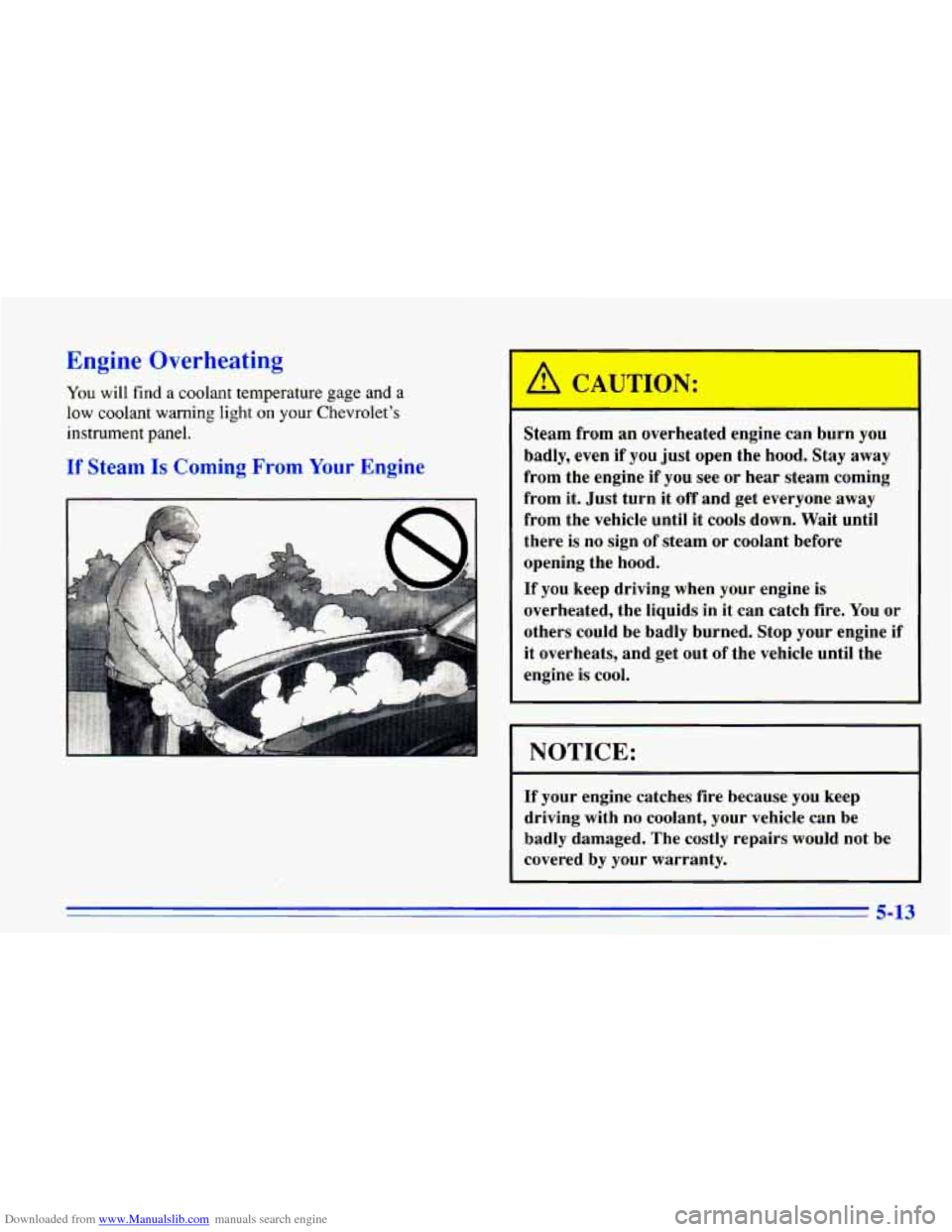
Downloaded from www.Manualslib.com manuals search engine Engine Overheating
You will find a coolant temperature gage and a
low coolant warning light on your Chevrolet’s
instrument panel. Steam
from an overheated engine can burn you
badly, even if you just open the hood. Stay away
from the engine if you
see or hear steam coming
from it. Just turn it
off and get everyone away
from the vehicle until it cools down. Wait until
there is no sign of steam or coolant before
opening the hood.
If you keep driving when your engine
is
overheated, the liquids in it can catch fire. You or
others could be badly burned. Stop your engine
if
it overheats, and get out of the vehicle until the
engine is cool.
I NOTICE:
If your engine catches fire because you keep
driving with no coolant, your vehicle can be
badly damaged. The costly repairs would not be
covered by your warranty.
5-13
Page 260 of 372
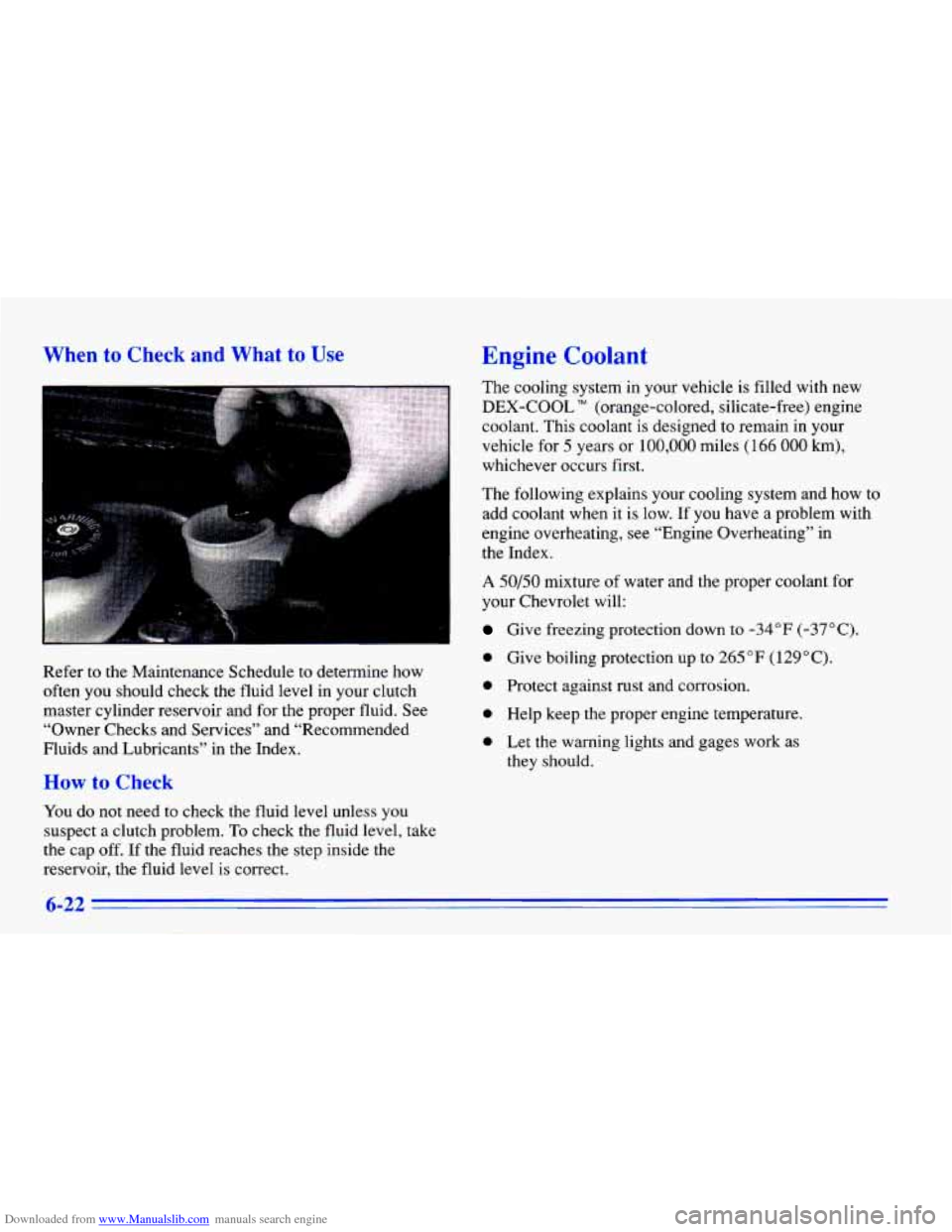
Downloaded from www.Manualslib.com manuals search engine When to Check and What to Use
Refer to the Maintenance Schedule to determine how
often you should check the fluid level in your clutch
master cylinder reservoir and for the proper fluid. See
“Owner Checks and Services” and “Recommended
Fluids and Lubricants” in the Index.
How to Check
You do not need to check the fluid level unless you
suspect a clutch problem. To check the fluid level, take
the cap off.
If the fluid reaches the step inside the
reservoir, the fluid level
is correct.
Engine Coolant
The cooling system in your vehicle is filled with new
DEX-COOL TM (orange-colored, silicate-free) engine
coolant. This coolant is designed to remain in your
vehicle for
5 years or 100,000 miles ( 166 000 km),
whichever occurs first.
The following explains your cooling system and how to
add coolant when it is low. If you have a problem with
engine overheating, see “Engine Overheating” in
the Index.
A 50/50 mixture of water and the proper coolant for
your Chevrolet will:
Give freezing protection down to -34°F (-37OC).
e Give boiling protection up to 265 “F (129°C).
0 Protect against rust and corrosion.
e Help keep the proper engine temperature.
e Let the warning lights and gages work as
they should.
6-22
Page 266 of 372
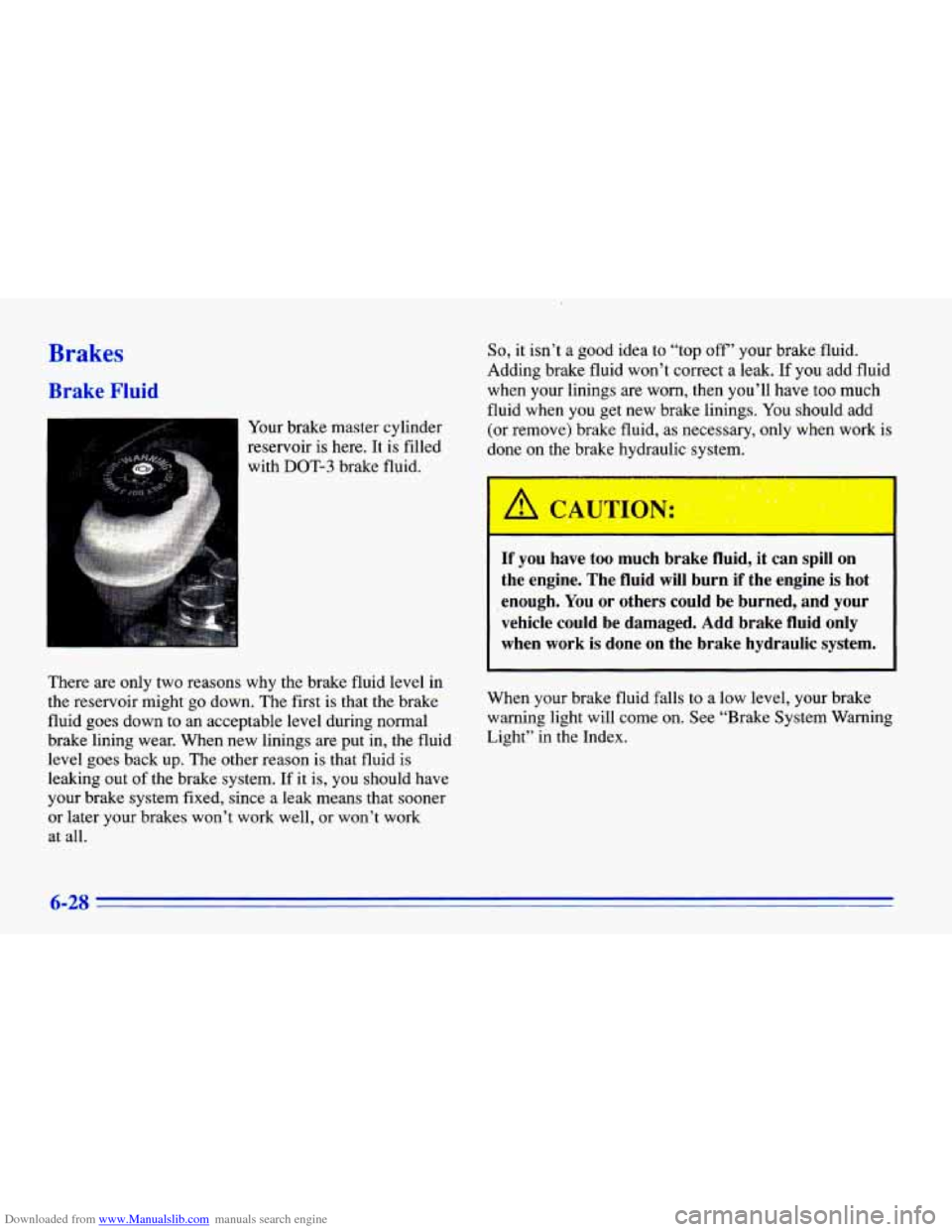
Downloaded from www.Manualslib.com manuals search engine Brakes
Brake Fluid
Your brake master cylinder
reservoir
is here. It is filled
with
DOT-3 brake fluid.
So, it isn’t a good idea to “top off’’ your brake fluid.
Adding brake fluid won’t correct a leak.
If you add fluid
when your linings
are worn, then you’ll have too much
fluid when you get new brake linings. You should add
(or remove) brake fluid, as necessary, only when work
is
done on the brake hydraulic system.
There are only two reasons why the brake fluid level in
the reservoir might go down. The first
is that the brake
fluid goes down to an acceptable level during normal
brake lining wear. When new linings are put in, the fluid
level goes back up. The other reason is that fluid is
leaking out of the brake system.
If it is, you should have
your brake system fixed, since a leak means that sooner or later your brakes won’t work well, or won’t work
at all.
If you have too much brake fluid, it can spill on
the engine. The fluid will burn if the engine is hot
enough.
You or others could be burned, and your
vehicle could be damaged. Add brake fluid only
when work is done on the brake hydraulic system.
When your brake fluid falls to a low level, your brake
warning light will come on. See “Brake System Warning
Light” in the Index.
6-28
Page 268 of 372
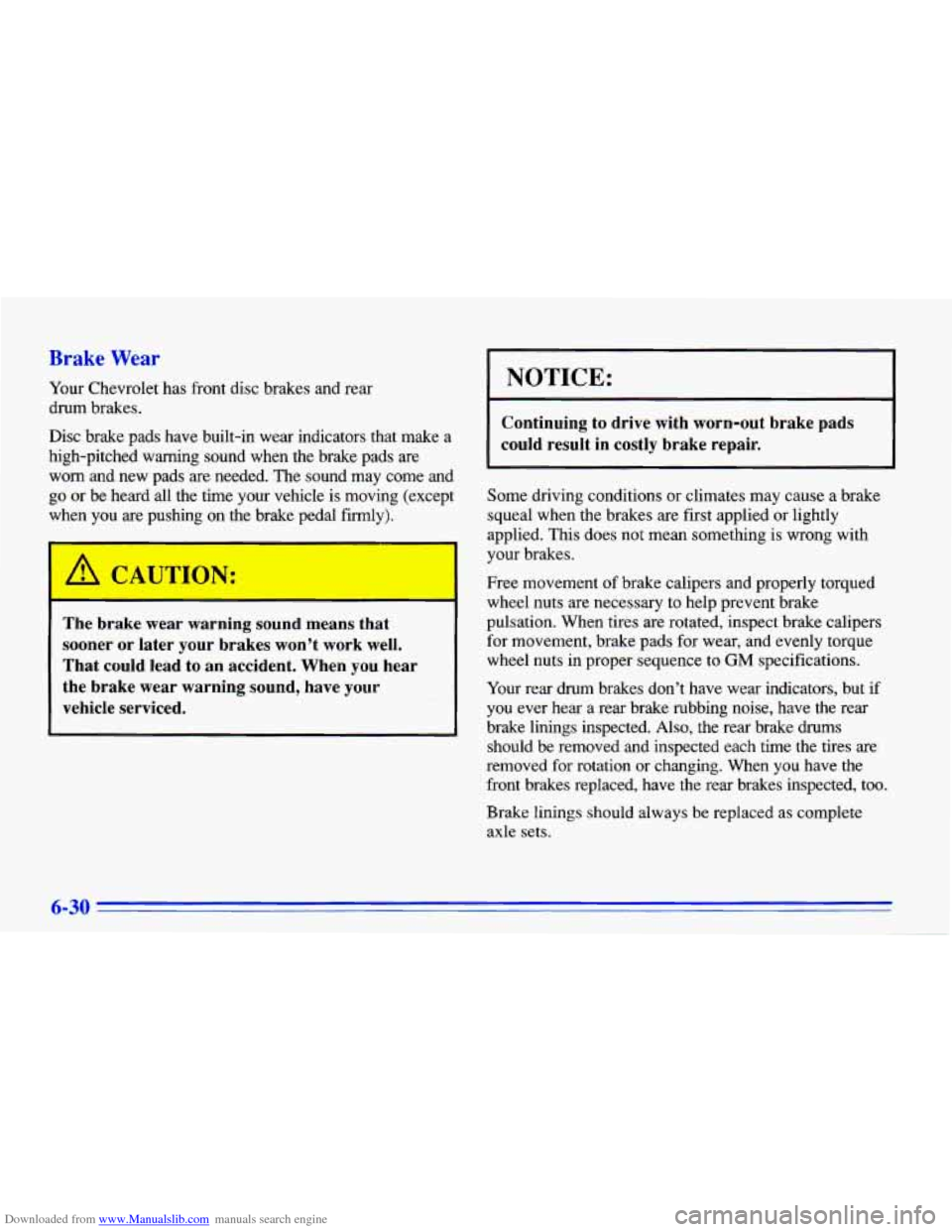
Downloaded from www.Manualslib.com manuals search engine Brake Wear
Your Chevrolet has front disc brakes and rear
drum brakes.
Disc brake pads have built-in wear indicators that make a
high-pitched warning sound when the brake pads are
worn and new pads
are needed. The sound may come and
go or be heard all the time your vehicle is moving (except
when you
are pushing on the brake pedal fiily).
L
The brake wear warning sound means that
sooner or later your brakes won’t work well.
That could lead to an accident. When you hear
the brake wear warning sound, have your
vehicle serviced.
NOTICE:
Continuing to drive with worn-out brake pads
could result in costly brake repair.
Some driving conditions or climates may cause a brake
squeal when the brakes are first applied or lightly
applied. This does not mean something is wrong with
your brakes.
Free movement of brake calipers and properly torqued
wheel nuts are necessary to help prevent brake
pulsation.
When tires are rotated, inspect brake calipers
for movement, brake pads for wear, and evenly torque
wheel nuts in proper sequence to
GM specifications.
Your rear drum brakes don’t have wear indicators, but if
you ever hear a rear brake rubbing noise, have the rear
brake linings inspected. Also, the rear brake drums
should be removed and inspected each time the tires are
removed for rotation
or changing. When you have the
front brakes replaced, have the rear brakes inspected, too.
Brake linings should always be replaced
as complete
axle sets.
6-30
Page 278 of 372
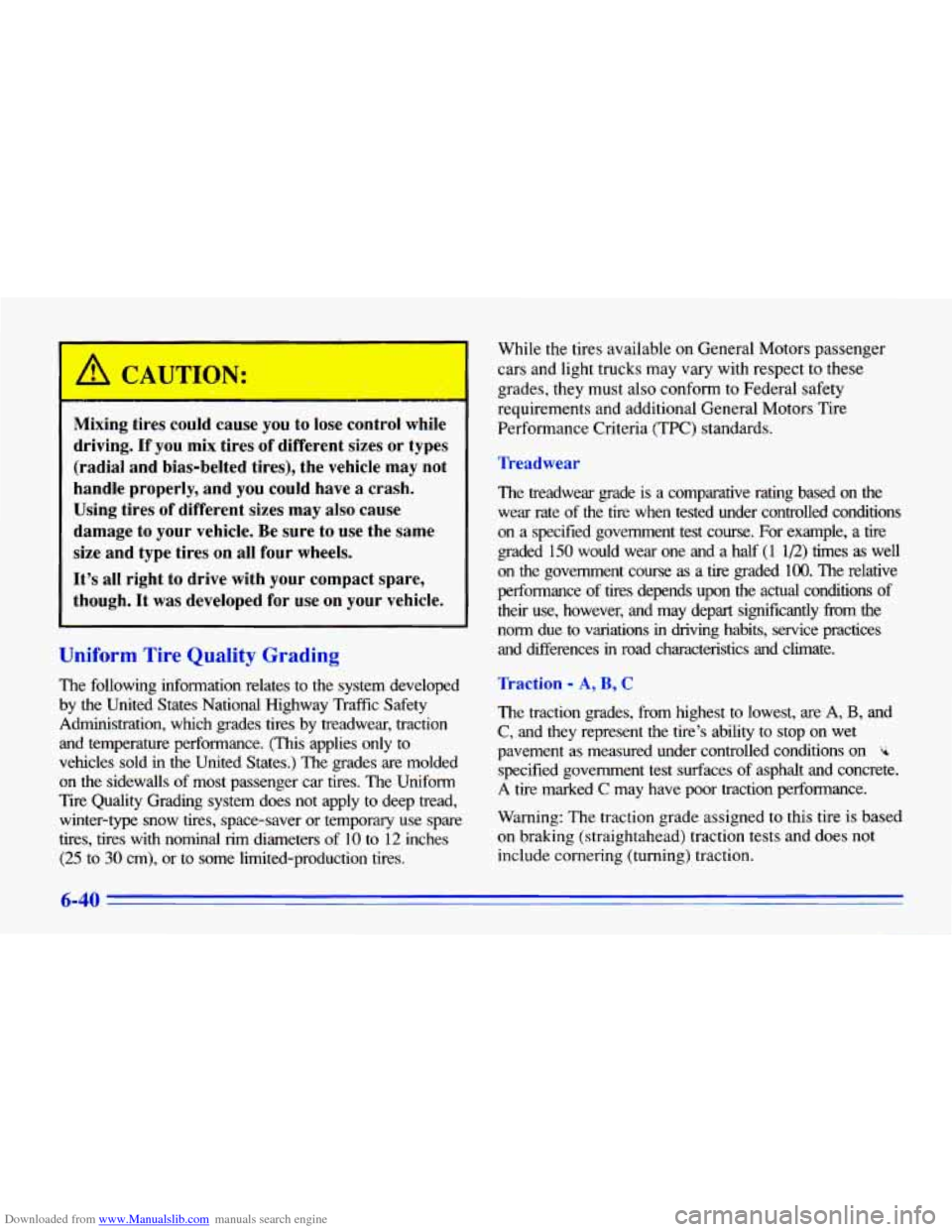
Downloaded from www.Manualslib.com manuals search engine Uniform Tire Quality Grading
The following information relates to the system developed
by the United States National Highway Traffic Safety Administration, which grades tires by treadwear, traction
and temperature performance.
(This applies only to
vehicles sold
in the United States.) The grades are molded
on the sidewalls of most passenger car tires. The Uniform
Tire Quality Grading system does not apply
to deep tread,
A CAUTION:
Mixing tires could cause you to lose control while
driving. If you mix tires of different sizes or types
(radial and bias-belted tires), the vehicle may not
handle properly, and
you could have a crash.
Using tires of different sizes may also cause
damage to your vehicle. Be sure to use the same
size and type tires on all four wheels.
It’s all right to drive with your compact spare,
though. It was developed for use on
your vehicle.
winter-type snow tires, space-saver or temporary use spare
tires, tires with nominal rim diameters of 10 to 12 inches
(25 to 30 cm), or to some limited-production tires. While
the tires available
on General Motors passenger
cars and light trucks may vary with respect
to these
grades, they must also conform
to Federal safety
requirements and additional General Motors Tire
Performance Criteria
(TPC) standards.
Treadwear
The treadwear grade is a comparative rating based on the
wear rate of the tire when tested under controlled conditions
on a specified government test course. For example, a tire
graded 150 would wear one and a half
(1 1/2) times as well
on
the government course as a tire graded 100. The relative
performance
of tires depends upon the actual conditions of
their use, however, and may depart significantly fiom the
norm due
to variations in driving habits, service practices
and differences in road characteristics and climate.
Traction - A, B, C
The traction grades, from highest to lowest, are A, B, and
C, and they represent the tire’s ability to stop on wet
pavement as measured under controlled conditions on
k
specified government test surfaces of asphalt and concrete.
A tire marked C may have poor traction performance.
Warning: The traction grade assigned to this tire is based
on braking (straightahead) traction tests and does not
include cornering (turning) traction.
6-40
Page 293 of 372
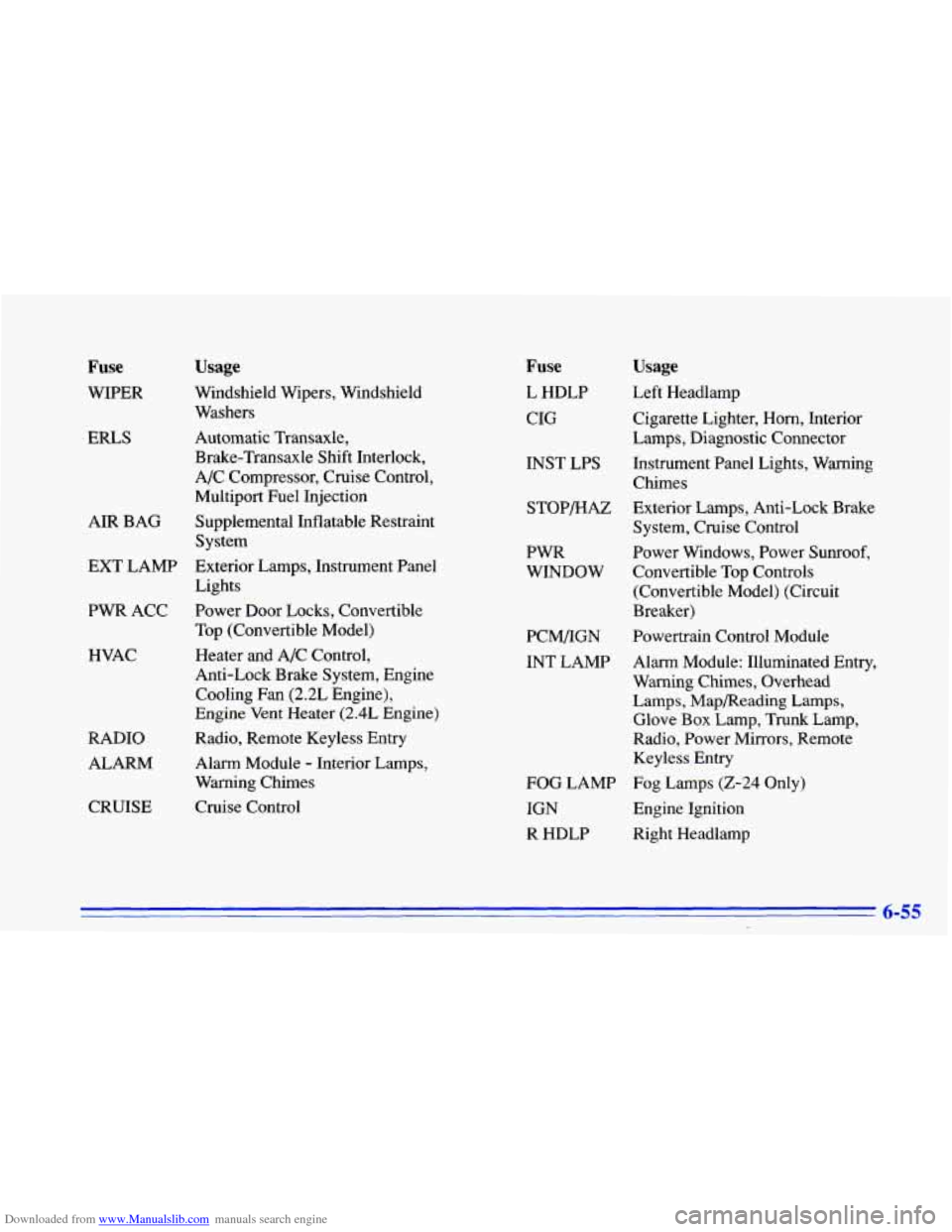
Downloaded from www.Manualslib.com manuals search engine Fuse Usage
WIPER Windshield Wipers, Windshield Washers
ERLS Automatic Transaxle,
Brake-Transaxle Shift Interlock,
A/C Compressor, Cruise Control, Multiport Fuel Injection
AIR BAG Supplemental Inflatable Restraint
EXT LAMP Exterior Lamps, Instrument Panel
PWR ACC Power Door Locks, Convertible System
Lights
Top (Convertible Model)
HVAC
RADIO ALARM
CRUISE Heater and
A/C Control,
Anti-Lock Brake System, Engine Cooling Fan (2.2L Engine),
Engine Vent Heater
(2.4L Engine)
Radio, Remote Keyless Entry
Alarm Module
- Interior Lamps,
Warning Chimes
Cruise Control
Fuse
L HDLP
CIG
INST LPS
STOP/HAZ
PWR
WINDOW
PCM/IGN
INT LAMP
FOG LAMP
IGN
R HDLP
Usage
Left Headlamp
Cigarette Lighter,
Horn, Interior
Lamps, Diagnostic Connector
Instrument Panel Lights, Warning Chimes
Exterior Lamps, Anti-Lock Brake
System, Cruise Control
Power Windows, Power
Sunroof,
Convertible Top Controls (Convertible Model) (Circuit
Breaker)
Powertrain Control Module
Alarm Module: Illuminated Entry,
Warning Chimes, Overhead
Lamps, Mapmeading Lamps,
Glove Box Lamp,
Trunk Lamp,
Radio, Power Mirrors, Remote
Keyless Entry
Fog Lamps (2-24 Only)
Engine Ignition
Right Headlamp
6-55
Page 359 of 372
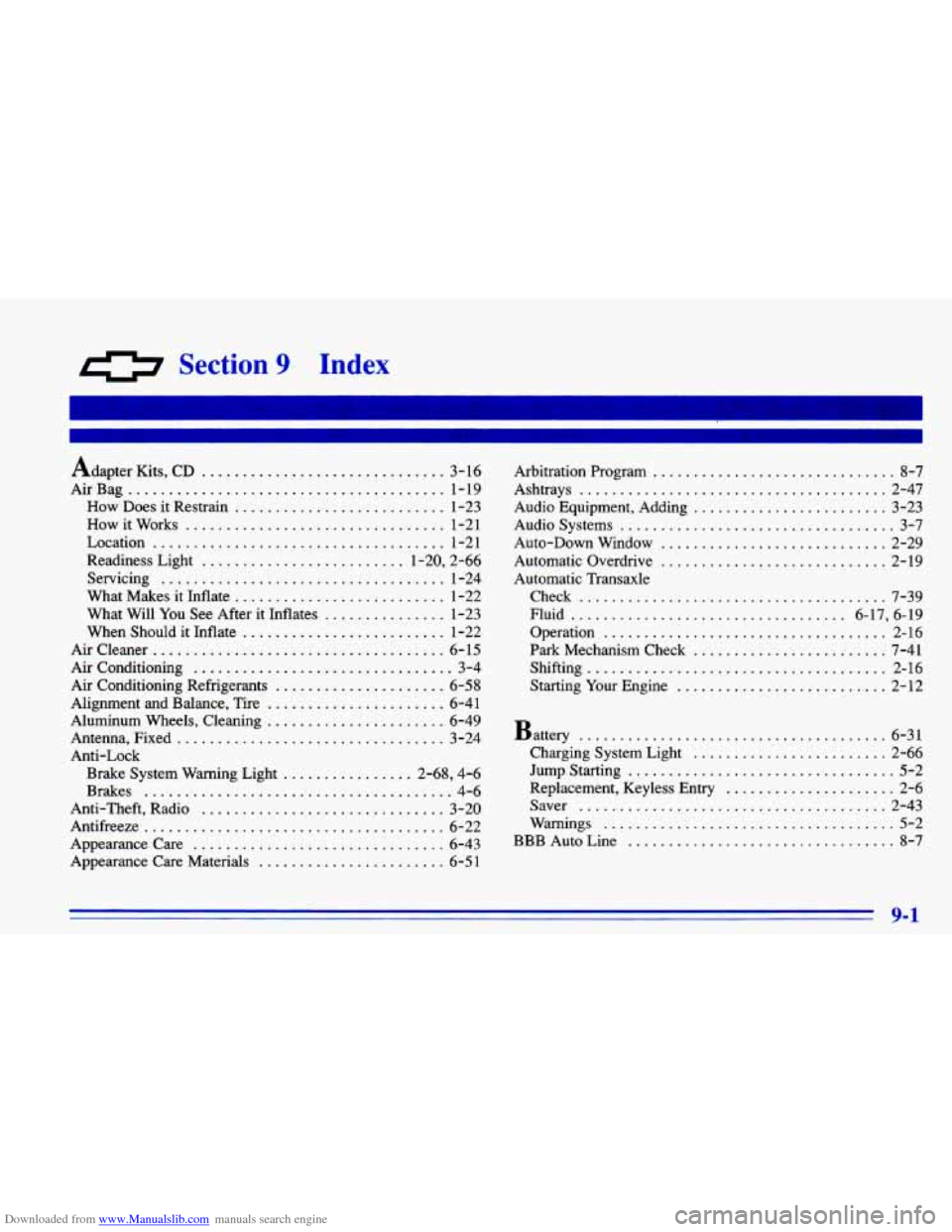
Downloaded from www.Manualslib.com manuals search engine 0 Section 9 Index
Adapter Kits. CD .............................. 3-16
AirBag
....................................... 1-19
How Does it Restrain
.......................... 1-23
How it Works
................................ 1-21
Location
.................................... 1-21
Readiness Light
......................... 1.20. 2.66
Servicing
................................... 1-24
What Makes
it Inflate .......................... 1-22
What Will You See After it Inflates
............... 1-23
When Should
it Inflate ......................... 1-22
Air Cleaner
.................................... 6- 15
Air Conditioning
................................ 3-4
Alignment and Balance. Tire
...................... 6-41
Aluminum Wheels. Cleaning
...................... 6-49
Antenna. Fixed
................................. 3-24
Anti-Lock Brake System Warning Light
................ 2.68. 4.6
Brakes
...................................... 4-6
Anti.Theft. Radio
.............................. 3-20
Antifreeze
..................................... 6-22
Appearance Care Materials
....................... 6-5 1
Air Conditioning Refrigerants ..................... 6-58
Appearancecare
............................... 6-43
Arbitration Program .............................. 8-7
Audio Equipment. Adding
........................ 3-23
Audio Systems
.................................. 3-7
Auto-Down Window
............................ 2-29
Automatic Overdrive
............................ 2-19
Automatic Transaxle Check
...................................... 7-39
Fluid
.................................. 6.17. 6.19
Operation
................................... 2-16
Park Mechanism Check
........................ 7-41
Shifting
..................................... 2-16
Startine Your Engine
.......................... 2-12
Ashtrays
...................................... 2-47
Battery
...................................... 6.3 1
Charging System Light ........................ 2-66
Jump Starting
................................. 5-2
Replacement. Keyless Entry
..................... 2-6
Saver
...................................... 2-43
Warnings
.................................... 5-2
BBB Auto Line
................................. 8-7
9-1
Page 360 of 372
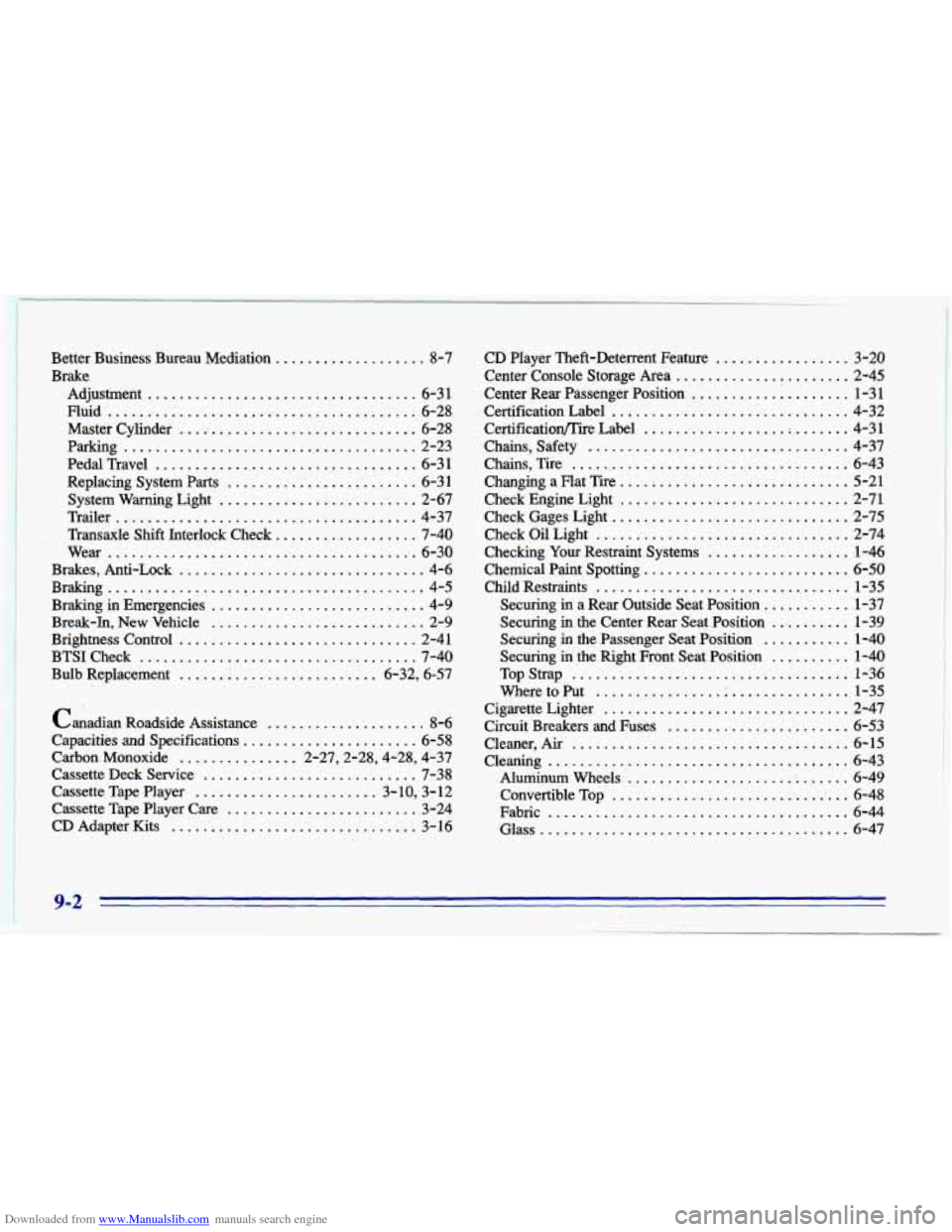
Downloaded from www.Manualslib.com manuals search engine Better Business Bureau Mediation ................... 8-7
Brake Adjustment
.................................. 6-3 1
Master Cylinder ............................... 6-28
Parking
..................................... 2-23
System Warning Light
......................... 2-67
Fluid
....................................... 6-28
Pedal Travel
.................................. 6-3 1
Replacing System Parts ........................ 6-31
Trailer
...................................... 4-37
Transaxle Shift Interlock Check
.................. 7-40
Wear
....................................... 6-30
Brakes. Anti-Lock
............................... 4-6
Braking
........................................ 4-5
Braking in Emergencies
........................... 4-9
Break-In. New Vehicle
........................... 2-9
BTSICheck
................................... 7-40
Bulb Replacement
...... .................. 6-32. 6-57
Brightness Control
.............................. 2-41
Canadian Roadside Assistance
.................... 8-6
Capacities and Specifications
...................... 6-58
Carbon Monoxide
............... 2.27.2.28.4.28. 4.37
Cassette Deck Service
........................... 7-38
Cassette Tape Player ....................... 3.10. 3.12
Cassette Tape Player Care
........................ 3-24
CD Adapter Kits
............................... 3- 16
CD Player Theft-Deterrent Feature ................. 3-20
Center Console Storage Area
...................... 2-45
Center Rear Passenger Position
.................... 1-31
Certification Label
.............................. 4-32
Certificatiooire Label
.................. ; ....... 4-31
Chains. Safety
................................. 4-37
Chains. Tire
................................... 6-43
Changing a Flat Tire
............................. 5-21
Check Engine Light
............................. 2-71
CheckGagesLight
.............................. 2-75
CheckOilLight
................................ 2-74
Checking
Your Restraint Systems .................. 1-46
Chemical Paint Spotting
.......................... 6-50
Child Restraints
................................ 1-35
Securing in a Rear Outside Seat Position
........... 1-37
Securing
in the Center Rear Seat Position .......... 1-39
Securing
in the Passenger Seat Position ........... 1-40
Securing in the Right Front Seat Position
.......... 1-40
TopStrap
................................... 1-36
WheretoPut
................................ 1-35
Cigarette Lighter
............................... 2-47
Circuit Breakers
and Fuses ....................... 6-53
Cleaner. Air ................................... 6-15
Cleaning
...................................... 6-43
Aluminum Wheels
............................ 6-49
Convertible
Top .............................. 6-48
Fabric ...................................... 6-44
Glass
....................................... 6-47
9-2 .